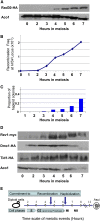Trans-Lesion DNA Polymerases May Be Involved in Yeast Meiosis
- PMID: 23550131
- PMCID: PMC3618350
- DOI: 10.1534/g3.113.005603
Trans-Lesion DNA Polymerases May Be Involved in Yeast Meiosis
Abstract
Trans-lesion DNA polymerases (TLSPs) enable bypass of DNA lesions during replication and are also induced under stress conditions. Being only weakly dependent on their template during replication, TLSPs introduce mutations into DNA. The low processivity of these enzymes ensures that they fall off their template after a few bases are synthesized and are then replaced by the more accurate replicative polymerase. We find that the three TLSPs of budding yeast Saccharomyces cerevisiae Rev1, PolZeta (Rev3 and Rev7), and Rad30 are induced during meiosis at a time when DNA double-strand breaks (DSBs) are formed and homologous chromosomes recombine. Strains deleted for one or any combination of the three TLSPs undergo normal meiosis. However, in the triple-deletion mutant, there is a reduction in both allelic and ectopic recombination. We suggest that trans-lesion polymerases are involved in the processing of meiotic double-strand breaks that lead to mutations. In support of this notion, we report significant yeast two-hybrid (Y2H) associations in meiosis-arrested cells between the TLSPs and DSB proteins Rev1-Spo11, Rev1-Mei4, and Rev7-Rec114, as well as between Rev1 and Rad30 We suggest that the involvement of TLSPs in processing of meiotic DSBs could be responsible for the considerably higher frequency of mutations reported during meiosis compared with that found in mitotically dividing cells, and therefore may contribute to faster evolutionary divergence than previously assumed.
Keywords: DNA repair; DSB processing; meiosis; recombination; trans-lesion synthesis polymerases.
Copyright © 2013 by the Genetics Society of America.
Figures




Similar articles
-
Timing of appearance of new mutations during yeast meiosis and their association with recombination.Curr Genet. 2020 Jun;66(3):577-592. doi: 10.1007/s00294-019-01051-0. Epub 2020 Jan 13. Curr Genet. 2020. PMID: 31932974
-
Interactions between Mei4, Rec114, and other proteins required for meiotic DNA double-strand break formation in Saccharomyces cerevisiae.Chromosoma. 2007 Oct;116(5):471-86. doi: 10.1007/s00412-007-0111-y. Epub 2007 Jun 9. Chromosoma. 2007. PMID: 17558514 Free PMC article.
-
Genetic Interactions of Histone Modification Machinery Set1 and PAF1C with the Recombination Complex Rec114-Mer2-Mei4 in the Formation of Meiotic DNA Double-Strand Breaks.Int J Mol Sci. 2020 Apr 12;21(8):2679. doi: 10.3390/ijms21082679. Int J Mol Sci. 2020. PMID: 32290544 Free PMC article.
-
Modulating and targeting meiotic double-strand breaks in Saccharomyces cerevisiae.Methods Mol Biol. 2009;557:27-33. doi: 10.1007/978-1-59745-527-5_3. Methods Mol Biol. 2009. PMID: 19799174 Review.
-
DNA double-strand breaks in meiosis: checking their formation, processing and repair.DNA Repair (Amst). 2009 Sep 2;8(9):1127-38. doi: 10.1016/j.dnarep.2009.04.005. Epub 2009 May 22. DNA Repair (Amst). 2009. PMID: 19464965 Review.
Cited by
-
Multifaceted activities of DNA polymerase η: beyond translesion DNA synthesis.Curr Genet. 2019 Jun;65(3):649-656. doi: 10.1007/s00294-018-0918-5. Epub 2018 Dec 8. Curr Genet. 2019. PMID: 30535880 Review.
-
DNA recombination. Recombination initiation maps of individual human genomes.Science. 2014 Nov 14;346(6211):1256442. doi: 10.1126/science.1256442. Science. 2014. PMID: 25395542 Free PMC article.
-
Elevated mutation rate during meiosis in Saccharomyces cerevisiae.PLoS Genet. 2015 Jan 8;11(1):e1004910. doi: 10.1371/journal.pgen.1004910. eCollection 2015 Jan. PLoS Genet. 2015. PMID: 25569256 Free PMC article.
-
Roles of exonucleases and translesion synthesis DNA polymerases during mitotic gap repair in yeast.DNA Repair (Amst). 2013 Dec;12(12):1024-30. doi: 10.1016/j.dnarep.2013.10.001. Epub 2013 Nov 5. DNA Repair (Amst). 2013. PMID: 24210827 Free PMC article.
-
Translesion synthesis polymerases contribute to meiotic chromosome segregation and cohesin dynamics in Schizosaccharomycespombe.J Cell Sci. 2020 May 22;133(10):jcs238709. doi: 10.1242/jcs.238709. J Cell Sci. 2020. PMID: 32317395 Free PMC article.
References
-
- Arora C., Kee K., Maleki S., Keeney S., 2004. Antiviral protein Ski8 is a direct partner of Spo11 in meiotic DNA break formation, independent of its cytoplasmic role in RNA metabolism. Mol. Cell 13: 549–559 - PubMed
MeSH terms
Substances
LinkOut - more resources
Full Text Sources
Other Literature Sources
Molecular Biology Databases
Miscellaneous
